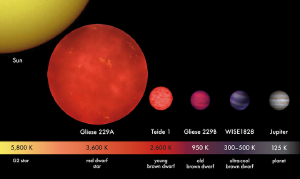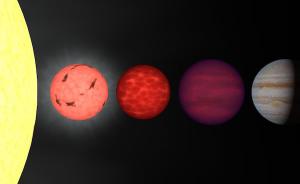Blog
Kicking Brown Dwarfs
Out Of The
Family Of Planets
31 January 2018
 MPIA/V. Joergens
MPIA/V. JoergensIf you want to start an argument among astronomers, ask them if Pluto is a planet.
In 2006 the International Astronomical Union (IAU) defined a planet as an object which 1) orbits the Sun, 2) is massive enough to be in hydrostatic equilibrium (basically that means it’s round), and 3) has cleared the neighborhood around its orbit. Since Pluto doesn’t satisfy the last criteria, they declared that Pluto was no longer a planet.
Naturally this upset a great many people, but it has also been controversial among astronomers, and there have been several proposals to change the definition, some that include Pluto, and some that don’t. But the IAU definition is mainly about how small a planet can be. Pluto isn’t a planet because it is too small to clear its orbit of similar bodies. But on the large side of things there is a similar problem. Where do we draw the line between a really large planet and a really small star?
 NASA/IPAC/R. Hurt (SSC)
NASA/IPAC/R. Hurt (SSC)The usual definition is that a star undergoes nuclear fusion within its core, while a planet does not. Thus Jupiter is a planet, while Trappist-1 is a star. Trappist-1 is about the same size as Jupiter but 100 times more massive, and clearly undergoes nuclear fusion. Based on theoretical models, a body needs about 90 Jupiter masses in order for hydrogen to fuse into helium in its core, so you could argue that anything less than 90 Jupiter masses is a planet.
But then there is the problem of brown dwarfs. Brown dwarfs are objects with a mass between about 15 and 90 Jupiters. They are too small to fuse hydrogen like a star, but they don’t really look like planets, particularly on the larger end. A young brown dwarf with a mass of about 80 Jupiters is a gaseous body with a surface temperature of more than 2000 K. It looks like a cool star rather than a large planet. It seems odd to call a star-sized object that gives off a warm red glow a planet. But since brown dwarfs cool as they age, an old brown dwarf could look very much like Jupiter, so calling it a planet seems reasonable.
But now there’s a proposal to define large planets not by their mass, but how they form. Stars and planets form very differently. A star forms when a cloud of gas and dust collapses under its own gravitational weight. This is known as top-down formation. Planets, on the other hand, start as smaller rocky bodies that capture more gas and dust over time, known as bottom-up formation. This difference is important, because it means that planets can only form in an environment where there is plenty of “rocky” material such as iron, carbon and silicon. Stars, on the other hand only need hydrogen and helium to form, though they can also have other materials. The amount of rocky materials in a star system can be determined by measuring the metallicity of a star. In astronomy, “metal” just means anything other than hydrogen and helium. So stars with a higher metallicity are more likely to have planets, since the gas cloud from which it formed had plenty of rocky materials.
Recently Kevin Schlaufman looked at brown dwarfs orbiting a larger star, and compared the masses of these brown dwarfs to the metallicities of their stars.1 He found that stars with higher metallicity had all different sizes of brown dwarfs, but stars with lower metallicity only had brown dwarfs larger than about 10 Jupiter masses. This means that brown dwarfs larger than 10 Jupiter masses likely form from the top-down method of stars rather than the bottom-up method of planets. This opens up a new definition for planets. Bodies smaller than 10 Jupiter masses are planets, larger than 90 Jupiter masses are stars, and in between are brown dwarfs that share properties similar to both.
Kevin C. Schlaufman. Evidence of an Upper Bound on the Masses of Planets and Its Implications for Giant Planet Formation. The Astrophysical Journal, Volume 853, Number 1 (2018) ↩︎